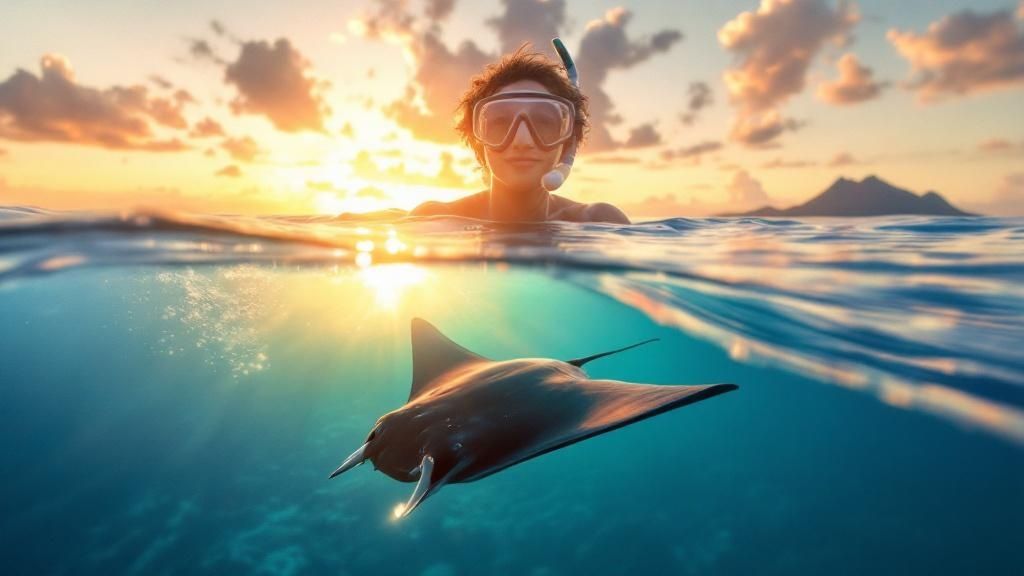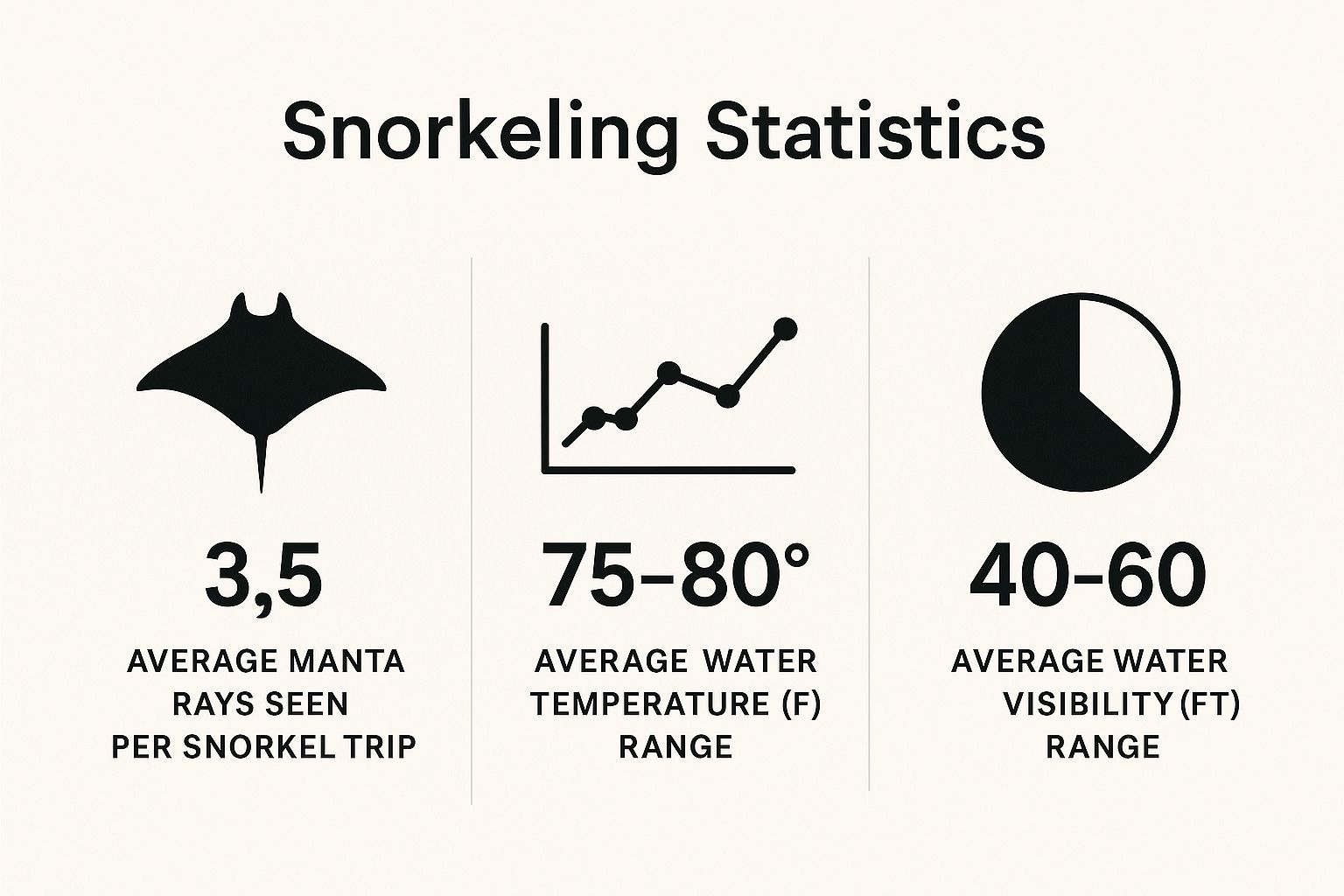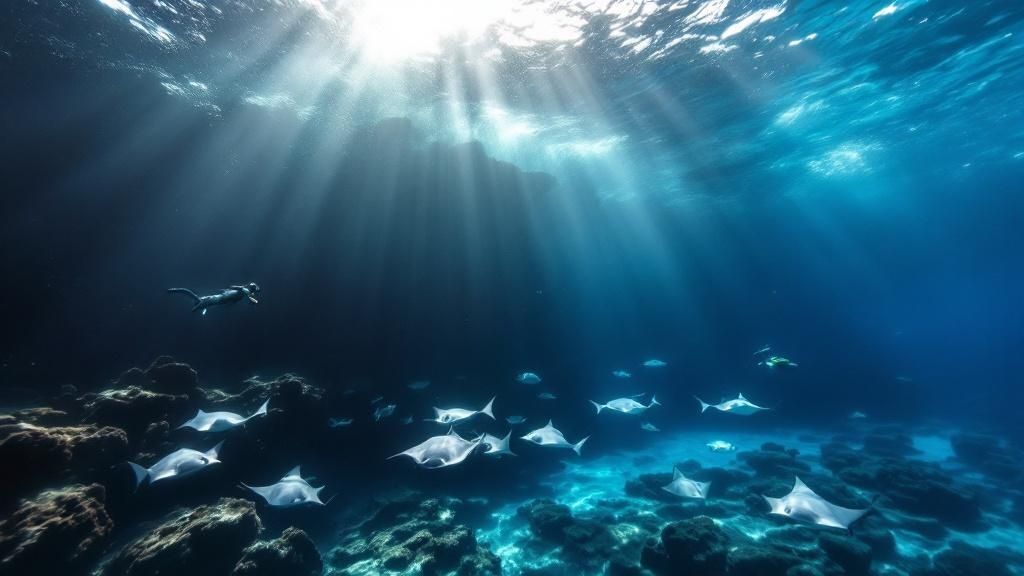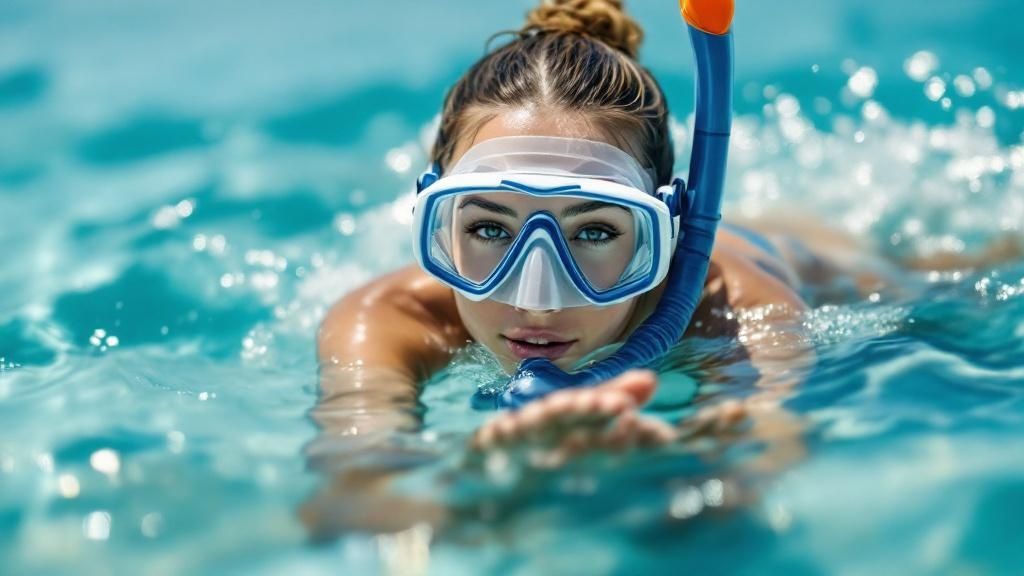Manta Ray Snorkel Kona: Complete Hawaii Adventure Guide
- Byron
- May 31
- 13 min read
Why Kona Delivers The Planet's Best Manta Ray Encounters

Kona, Hawaii, isn't just a beautiful island destination; it's a world-renowned haven for manta rays. Many consider Kona to offer the best manta ray encounters on the planet. This isn't by chance. A unique combination of factors creates this underwater paradise, making it a must-see for any ocean lover.
The Volcanic Advantage
The volcanic rock formations of the Kona Coast play a critical role in this special ecosystem. These rocks provide shelter for the manta rays and also function as cleaning stations. Small fish gather at these stations, picking off parasites and dead skin from the mantas. This symbiotic relationship benefits both the mantas and the cleaner fish, contributing to the overall health of the manta ray population.
This healthy environment naturally attracts more manta rays, making Kona a prime viewing spot.
A Plankton Buffet
The nutrient-rich currents around Kona support robust plankton blooms. Plankton, these tiny organisms, are the main food source for manta rays. Kona’s waters are essentially an all-you-can-eat buffet for these gentle giants. This readily available food source helps explain why manta ray sightings are so frequent in Kona.
This natural phenomenon makes manta ray snorkel Kona a truly special experience. In fact, manta ray snorkeling in Kona boasts an impressive 80-90% sighting success rate year-round, attracting roughly 80,000 participants annually. For more detailed statistics, check out: Manta Ray Snorkel Kona Unforgettable Hawaii Marine Tours.
Underwater Topography: A Natural Feeding Ground
The unique underwater topography of Kona also contributes to this incredible manta ray habitat. The Kona Coast is characterized by dramatic slopes and deep drop-offs. These create upwelling zones where nutrient-rich water rises to the surface. This further concentrates the plankton, providing predictable feeding grounds for manta rays and making Kona a reliable location for unforgettable encounters.
Decades of Conservation
Finally, decades of dedicated conservation efforts and responsible tourism practices have helped protect this delicate ecosystem. Local regulations and guidelines ensure that tour operators minimize their impact on the manta rays and their environment. This commitment to sustainability helps ensure that these incredible experiences will remain available for generations to come. You can enjoy your manta ray snorkel Kona adventure knowing you are participating in a responsible and sustainable activity.
Finding The Perfect Snorkeling Spots In Kona Waters
Not all Kona waters offer the same chances of seeing manta rays. Picking the right spot can significantly improve your manta ray snorkel Kona adventure. This section explores Kona's best manta ray locations, highlighting what makes each special and how factors like moon phases, currents, and weather can affect your experience.
Kona's Manta Ray Hotspots: A Closer Look
Kona has several well-known spots for manta ray encounters, each with its own distinct features:
Manta Village (Garden Eel Cove): This shallow cove is known for reliable sightings and calm, clear water, perfect for beginners. The shallow depth makes it a great option for families and those new to snorkeling.
Manta Heaven (Keauhou Bay): Located near the Kona Airport, this spot is famous for the large number of manta rays that gather here, increasing your odds of a close encounter. Experienced snorkelers might enjoy the slightly deeper water and potential for more manta ray activity.
Manta Point (Mauna Kea Beach Hotel): Access is limited because it's on private property, but this shoreline spot provides a unique perspective for watching manta rays.
These tours are popular thanks to the unique nighttime setting, where snorkelers watch manta rays feeding on plankton drawn in by underwater lights. Manta Village (Garden Eel Cove) and Manta Heaven (Keauhou Bay) are especially known for consistent sightings. Manta Village offers shallow depths good for all skill levels, while Manta Heaven boasts calmer waters. Find additional insights about this unique experience here.
Understanding Environmental Influences
Several natural factors can impact your manta ray viewing. Moon phases, for instance, affect plankton visibility. Darker nights often mean more manta ray activity near the surface. Seasonal currents influence water temperature and clarity, and understanding these patterns can help predict the best viewing times. Also, weather like wind and rain can affect visibility and tour availability, especially in winter.

The infographic above shows key data for your manta ray snorkel Kona trip, including average manta ray sightings, typical water temperatures, and average water visibility. The data reveals that while water temperatures are fairly steady, visibility and manta ray numbers can change. This highlights the importance of choosing the right location and time of year. You might be interested in: Top Tips & Must-See Spots for Manta Ray Snorkel Kona.
To help you choose the best spot for your experience level and desired conditions, take a look at the comparison table below:
Kona Manta Ray Snorkeling Locations Comparison
This table compares key features, depth levels, and suitability of different manta ray snorkeling spots in Kona.
Location | Depth Range | Experience Level | Best Conditions | Unique Features |
|---|---|---|---|---|
Manta Village (Garden Eel Cove) | Shallow | Beginner | Calm, clear waters | Ideal for families and new snorkelers |
Manta Heaven (Keauhou Bay) | Moderate | All Levels | Calm waters | High concentration of manta rays |
Manta Point (Mauna Kea) | Moderate | All Levels | Clear waters | Shoreline access, restricted access |
As you can see, each location offers a unique snorkeling experience. Manta Village is perfect for those new to snorkeling or families with young children, while Manta Heaven offers the best chance to see a large number of manta rays. Manta Point, while requiring access permissions, provides a different perspective from the shoreline.
By understanding these factors and choosing your spot carefully, you can maximize your chances of a truly memorable manta ray encounter in Kona.
Planning Your Dream Manta Ray Adventure Like A Pro

Transforming a good manta ray snorkel experience in Kona into a truly unforgettable one hinges on careful planning. This involves considering every detail, from the ideal time of year to the essential gear. A little foresight will ensure a smooth and rewarding adventure.
Timing Is Everything: Seasons and Scheduling
Manta rays grace Kona's waters throughout the year. However, the dry season (April-October) typically offers calmer seas and increased visibility, creating optimal snorkeling conditions. Summer (June-August) is peak season, so booking well in advance is essential due to high demand.
Even during the winter months, magical encounters are possible. Be prepared for potential weather-related rescheduling, especially between January and mid-March. Flexibility is key to a successful trip.
Another important decision is choosing between a daytime or nighttime experience. Night snorkeling offers a unique spectacle, with illuminated plankton attracting feeding manta rays. Daytime viewings, however, allow for appreciating the manta rays' subtle coloration and often less crowded interactions.
Gearing Up for Success: Essentials and Extras
Proper gear is essential for your Kona manta ray adventure. A wetsuit, even in warmer months, provides added comfort and warmth, especially during night excursions. Underwater cameras, particularly those with low-light capabilities, allow you to capture the magic. Remember: no flash photography!
Don't forget basic essentials like a towel and dry clothes for afterward. If you are prone to seasickness, consider precautions like motion sickness medication.
Setting Expectations: The Wild Factor
It's crucial to remember that manta rays are wild animals. While Kona boasts an impressive 80-90% sighting success rate, there are no guarantees. Setting realistic expectations, while still embracing the magic of the encounter, will enhance your experience.
This mindset allows you to appreciate the ocean's beauty, regardless of manta ray sightings. Many reputable tour operators, like Manta Ray Night Snorkel Kona, offer a "manta guarantee," allowing you to reschedule if your initial tour yields no sightings.
What Really Happens During Your Manta Ray Encounter
Slipping into Kona's warm waters at night, under the moon and stars, sets the stage for an unforgettable manta ray experience. Knowing what to expect can make the magic even more profound. This section details a typical manta ray snorkel Kona adventure, from your first steps into the water to witnessing the mesmerizing dance of the feeding manta rays.
From Boat to Board: Your First Moments
Most manta ray night snorkel tours start with a short boat trip to a designated viewing area. This is where the adventure truly begins. Tour operators usually use submerged lights attached to a floating platform or board to attract plankton. This, in turn, draws the manta rays, creating a predictable feeding area for easy observation. You'll be instructed to hold onto the board, keeping your body still to minimize any disturbance. This provides the perfect viewing platform for the spectacle that's about to unfold.
The Manta Ray Ballet: An Underwater Spectacle
As the plankton gathers, the manta rays appear, often seeming like ghostly shadows rising from the deep. Their movements are both powerful and graceful. They frequently perform barrel rolls and loop-de-loops while feeding on the concentrated plankton. These captivating feeding displays can last for a considerable time, providing ample opportunities to observe their incredible agility and unique feeding techniques. This natural behavior, illuminated by the underwater lights, creates a truly surreal and captivating spectacle. Learn more in our article about Manta Ray Night Snorkel – Magical Hawaii Adventure.
Respectful Observation: Your Role in the Encounter
While this experience is exhilarating, it's vital to remember that these are wild animals. Maintaining a respectful distance and following your guide's instructions ensures both your safety and the well-being of the manta rays. Avoid touching them, as their skin is covered with a protective mucous layer essential for their health. Flash photography is also discouraged, as it can disorient and stress the animals. By adhering to these guidelines, you can fully appreciate the encounter's magic while contributing to responsible wildlife viewing. This allows you to participate in their conservation, not just observe it.
Common Concerns and Comfort: Easing Your Mind
Some people might feel anxious about night swims. However, the presence of experienced guides, the security of the floating platform, and the use of flotation devices, like pool noodles, create a safe and comfortable environment. Your guides will be available to answer any questions and ensure a positive experience. This, combined with the awe-inspiring encounter, will quickly replace any initial apprehension with wonder.
Supporting Manta Ray Research And Conservation Efforts

Behind every magical manta ray snorkel Kona experience lies a dedicated effort to understand and protect these gentle giants. This research is crucial for ensuring these encounters are both possible and sustainable. Let's explore how these initiatives contribute to our knowledge of Kona's manta ray population.
Unveiling The Secrets Of Manta Rays: Research In Action
Researchers use a variety of techniques to study manta rays, including individual identification and long-term behavioral studies. Just like human fingerprints, each manta ray has a unique spot pattern on its underside.
This allows scientists to track individual mantas over time. Tracking reveals vital information about their migration patterns, social interactions, and overall population health. For instance, data can reveal how far mantas travel, preferred feeding areas, and habitat usage.
This knowledge is essential for developing effective conservation strategies.
The Power Of Citizen Science: Your Contribution Matters
Joining a manta ray snorkel Kona tour allows you to contribute to ongoing research. Many tour operators gather citizen science data during their trips.
This often includes manta ray sightings, observed behaviors, and environmental conditions. When compiled and analyzed, this information provides valuable insights into population trends and behavioral changes.
Furthermore, revenue from responsible tourism directly supports habitat protection and research. This transforms you from a passive observer into an active participant in conservation. The Kona Coast has been a significant location for manta ray statistics and research.
Kona Coast Manta Ray Statistics
Since 2009, detailed statistics on manta ray sightings have been collected, providing insights into encounter frequency and patterns. Organizations like Manta Ray Advocates Hawaii play a crucial role in maintaining these records. The data is often compiled through personal observations and video footage reviews. You can find detailed statistics here.
From Tourism To Conservation: The Ripple Effect
Your tourism dollars directly support manta ray conservation efforts. Tour operators prioritizing sustainable practices often reinvest profits into research, habitat restoration, and education.
For example, some operators partner with researchers to tag and track manta rays or support initiatives to reduce marine debris. This cycle of responsible tourism ensures the health and vitality of Kona's manta ray population for generations to come.
Learn more about manta ray snorkeling in Kona: Manta Ray Snorkel Kona: Complete Guide To Magical Encounters. Understanding the link between research, conservation, and responsible tourism allows you to appreciate the impact of your manta ray snorkel Kona adventure. Each encounter becomes not just a personal experience but a contribution to the well-being of these magnificent creatures.
Selecting Tour Operators Who Deliver Exceptional Experiences
With so many tour operators offering manta ray snorkel adventures in Kona, choosing the right one can make or break your trip. Selecting a reputable operator elevates a good experience to an extraordinary one. This guide will walk you through the key factors that distinguish exceptional operators from the rest, covering everything from safety and environmental practices to guide expertise and group sizes.
Essential Qualities of Top-Tier Operators
Exceptional manta ray tour operators prioritize both guest experience and marine conservation. This commitment shines through in several key practices. Maintaining small group sizes, for instance, ensures personalized attention from the guides and minimizes disturbance to the manta rays. Employing experienced, certified guides with in-depth knowledge of manta ray behavior and the local ecosystem is also crucial.
Prioritizing safety protocols, including thorough briefings, proper equipment, and adherence to responsible wildlife viewing guidelines, is another hallmark of a great operator. Learn more in our article about Manta Ray Snorkel Kona: Top Tours & Experience Tips.
Decoding Tour Formats, Boats, and Pricing
Understanding the differences between tour formats, boat types, and pricing structures empowers you to make informed decisions. Tour formats range from basic snorkeling excursions to combined sunset and night tours. Boat types vary in size and amenities, impacting comfort and accessibility. Pricing typically reflects the level of service, group size, and inclusions such as equipment rental or photography packages.
To help you compare these options, we've created a helpful table:
To help you choose the best tour, let's explore the criteria for selecting a manta ray snorkel tour operator in Kona:
Criteria | What to Look For | Red Flags | Why It Matters |
|---|---|---|---|
Group Size | Small groups (6-12 people) | Large, crowded boats (20+ people) | Smaller groups allow for more personalized attention from guides and minimize disturbance to the manta rays. |
Guide Experience & Certification | Certified guides with extensive knowledge of manta rays and the local ecosystem | Inexperienced guides or lack of certification | Experienced guides enhance the educational value of the tour and ensure guest safety. |
Safety Protocols | Thorough safety briefings, well-maintained equipment, adherence to wildlife viewing guidelines | Lack of clear safety procedures or outdated equipment | Safety should always be a top priority. Proper protocols and equipment minimize risks. |
Environmental Practices | Commitment to sustainable tourism, minimizing environmental impact | Disregard for environmental regulations | Choosing an eco-conscious operator helps protect the manta ray population and their habitat. |
Reviews & Reputation | Consistently positive reviews, recommendations from trusted sources | Numerous negative reviews mentioning overcrowding, unprofessional behavior, or safety concerns | Reviews offer valuable insights from past guests and can indicate the operator's overall quality. |
Tour Inclusions | Clearly stated inclusions such as equipment rental, wetsuits, photography packages | Hidden fees or unexpected extra charges | Transparency in pricing helps avoid surprises and ensures you get what you pay for. |
Manta Guarantee | Some operators offer a "manta guarantee," offering a free trip if no mantas are sighted | Lack of flexibility or unwillingness to accommodate guests if mantas aren't sighted | A manta guarantee provides peace of mind and demonstrates the operator's commitment to guest satisfaction. |
This table highlights key factors to consider when choosing a manta ray tour operator. Smaller groups often offer a more intimate experience, while larger boats might provide more amenities but a less personal experience.
Asking the Right Questions: Unveiling Operator Commitment
Asking direct questions can reveal an operator's true dedication to quality. Here are some key inquiries to consider:
What is the operator's safety record?
Do they follow sustainable tourism practices?
What is their cancellation policy?
What is included in the tour price (e.g., equipment, wetsuits)?
What is the average group size?
Do they offer a "manta guarantee"?
These questions will help you assess the operator's commitment to safety, environmental responsibility, and guest satisfaction.
Red Flags: Indicators of Potential Issues
Beware of operators who downplay safety, overcrowd their boats, or disregard environmental regulations. These are red flags that suggest a potential lack of commitment to quality. For example, insufficient safety briefings or a reluctance to discuss environmental practices could signal underlying issues. Consistently negative reviews highlighting overcrowding or unprofessional guide behavior are also warning signs.
By considering these factors and asking the right questions, you can choose a manta ray snorkel Kona operator who prioritizes your enjoyment and the health of the manta ray population. This thoughtful approach ensures your experience is not only unforgettable but also contributes to responsible and sustainable tourism. The right operator will enrich your adventure with expert knowledge and a genuine passion for these magnificent creatures.
Maximizing Every Moment Of Your Kona Manta Ray Experience
Your manta ray adventure goes beyond just the time you spend in the water. A little planning can greatly enhance the magic of the experience. This guide offers insider tips for making the most of your manta ray snorkel Kona trip, from capturing amazing photos to contributing to conservation efforts.
Capturing Underwater Magic: Photography and Videography Tips
Seeing these gentle giants is breathtaking, but photos and videos allow you to relive those moments. It’s important, however, to document responsibly. Avoid flash photography, which can disorient and stress the manta rays. Opt for a camera with strong low-light capabilities. Many GoPro and similar action cameras excel in these conditions.
For the best photos, consider these techniques:
Adjust Camera Settings: Before your trip, test various ISO levels and shutter speeds to find what works best in low light.
Use Red Filters: Red filters can improve colors and compensate for the loss of red light underwater, particularly helpful during daytime dives.
Practice Patience: Manta rays are graceful, but their movements can be unpredictable. Patience and observation are key to capturing the perfect shot.
Choosing the Right Time: Seasonal Variations and Optimal Viewing Times
Kona's manta rays are present year-round, but the dry season (April-October) generally provides calmer waters and better visibility. The summer months (June-August) offer excellent conditions, but require booking well in advance due to high demand.
Winter (November-March) can bring increased wind and rougher seas, which can affect visibility and comfort. While tours operate year-round, flexibility is important due to potential weather-related rescheduling, particularly during January to mid-March.
Daytime versus nighttime viewings offer distinct experiences. Night snorkeling, illuminated by underwater lights attracting plankton, provides a unique look at feeding manta rays. Daytime viewings, potentially less crowded, allow you to see the mantas’ subtle colors and natural behaviors.
Extending Your Adventure: Complementary Activities and Local Experiences
Your Kona manta ray snorkel trip can be part of a larger Hawaiian adventure. Extend your trip with other activities that complement your appreciation for the marine ecosystem:
Whale Watching Tours (Winter Months): Combine your manta ray experience with the excitement of seeing migrating humpback whales.
[Volcano National Park](https://www.nps.gov/havo/index.htm): Explore the striking volcanic landscapes that have shaped Kona’s unique environment.
Hawaiian Cultural Experiences: Immerse yourself in the local culture through traditional music, dance, and storytelling.
Transforming Encounters Into Lasting Memories: Journaling, Sharing, and Staying Connected
Your manta ray experience doesn't have to end when you leave the water. Here are ways to preserve the memories:
Journaling: Write down your impressions and feelings. Reflect on what you learned and observed.
Responsible Social Media Sharing: Share your photos and videos, but avoid geotagging specific locations to protect these habitats. Use your platform to educate others about manta ray conservation. Check out our guide on How to master...
Supporting Conservation: Connect with organizations like the Manta Pacific Research Foundation and [Manta Ray Advocates](https://mantarayadvocates.org/). Contribute to ongoing research and conservation efforts.
Ready for the magic of manta rays in Kona? Book your unforgettable adventure today! Manta Ray Night Snorkel Kona Hawaii Tours offers a variety of tours, ensuring a magical encounter with these graceful creatures. From sunset tours to private charters, we cater to all experience levels and group sizes, prioritizing safety, education, and responsible wildlife interaction.
Comments